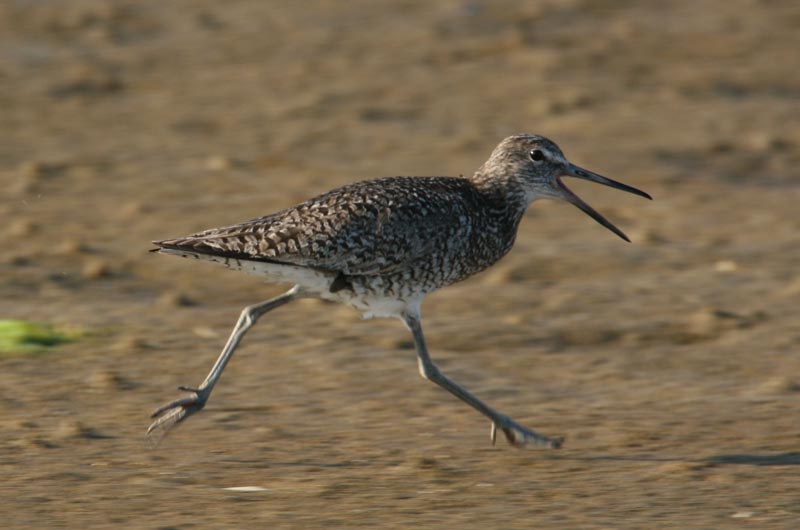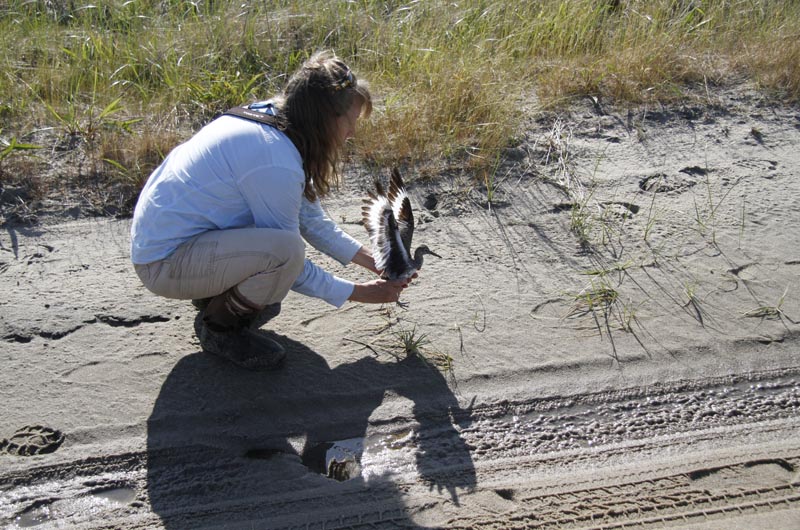At 6:45 a.m. on a Saturday morning near the Poucha Pond salt marsh at Chappaquiddick, a few fishermen lined the shores and a handful of binocular-bearing biologists and birders walked through the dunes. Otherwise, the land was bare of human activity.
But in the sky a bird with deep black and bright white striped wings swooped nearby. The binoculars went up.
“That’s a willet,” said Luanne Johnson, director of the nonprofit BiodiversityWorks dedicated to wildlife research, monitoring and mentoring.
With distinctive wings, willets are a relatively new arrival of shorebirds joining oystercatchers and piping plovers in their quest to nest on Martha’s Vineyard. They nest in salt marshes and back dunes, eating a variety of food, especially fiddler crabs.
Like other shorebirds, willets only nest on the Vineyard for a few short months. Also like other shorebirds, willets encounter many conservation challenges, including loss of shoreline and wetland habitat, predation and pollution.
While conservation groups on-Island can do their best to protect these birds in their summering habitat, this is only a piece of the puzzle.
“We want to know where these birds are going for the rest of their lives when they are not breeding in our salt marshes,” said Joe Smith, an ornithologist from New Jersey who is collaborating with the BiodiversityWorks team. Sheriff’s Meadow Foundation and the Trustees of Reservations are also collaborating in the migratory bird study.
Through the Daniels Wildlife Trust, BiodiversityWorks purchased four geolocators to help determine where the willets are traveling throughout the birds migration. But first, the birds have to be caught and tagged.
On Saturday, Ms. Johnson and Mr. Smith spotted a willet nest in the dunes and unraveled a long, thin mist net. They crept into the dunes, moving slow like lions on the hunt. With a quick hand signal from Mr. Smith, they leaped and swiped the soft net onto the bird.
The female willet sat tight on her nest, making her catch an easy one. The group, which also included BiodiversityWorks assistant director Liz Baldwin and Nature Conservancy restoration ecologist Matt Pelikan, caught and tagged three other willets throughout the weekend — on Poucha Pond, at Little Beach in Edgartown and on Cape Pogue.
Compared to the 48 pairs of piping plovers on the Island, Ms. Johnson only scouted 9 or 10 pairs of willets, and only began seeing them on the Vineyard about 20 years ago, although they are thought to have been prevalent in the 19th century.
In his book Birds of New England, Massachusetts ornithologist Edward Forbush wrote in 1912 that the willet “practically has disappeared from New England,” describing the bird and its eggs as delicacies.
He notes sightings of the bird near New Bedford as abundant in the mid 1850s to rare in 1901.
“It has vanished as a breeding bird,” he wrote. “This is one of the inevitable results of the spring and summer shooting so long permitted in all of the Atlantic coast States.”
But in 1918, the migratory bird act went into effect, in which the hunting, killing or taking of migratory birds became illegal. In the 1950s willets started to recolonize along the East Coast, slowly moving north, said Mr. Smith. Willets nest as far north as Nova Scotia and as far south as Mexico and the Caribbean.
Compared to oystercatchers or piping plovers, Mr. Smith said much less is known about the willet populations. For the past four years he has been researching willets in the Delaware Bay of New Jersey and tracking their migration through geolocators. In a three and a half day flight, the New Jersey willets travel to the coastline of Brazil, with a short stop between Guyana and French Guyana.
“The intent is to understand where the pinch points are in the life cycle,” Mr. Smith said. “We can’t imagine what problems they might be facing if they are wintering in South America, for example.”
“We don’t know whether they are facing the same struggles as some of our more well known beach nesting species are facing with population decline,” Mr. Smith said, adding that 40 per cent of North American shorebird species are declining.
The more willets from the East Coast being studied and tracked, the more information can be gathered and gaps can be filled, Mr. Smith said. He expects the willets to leave the Vineyard in mid-July and return next year mid to late-April.
Then, the “site-faithful” birds will be caught again, and the archival geolocator information will be analyzed.
“Catching a bird is easy,” Mr. Smith said. “Catching that bird will be much harder.”










Comments
Comment policy »